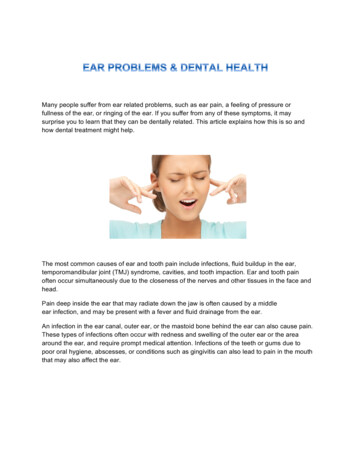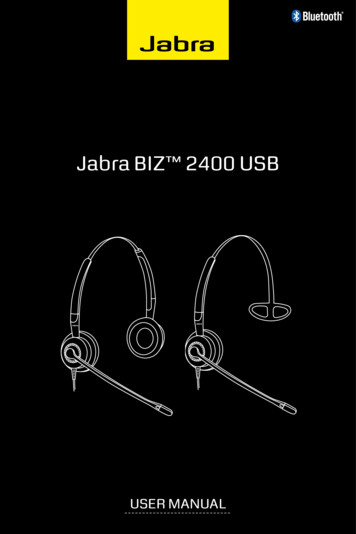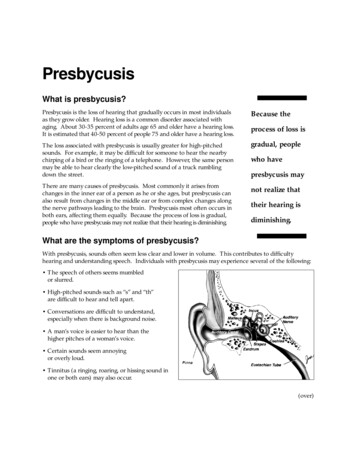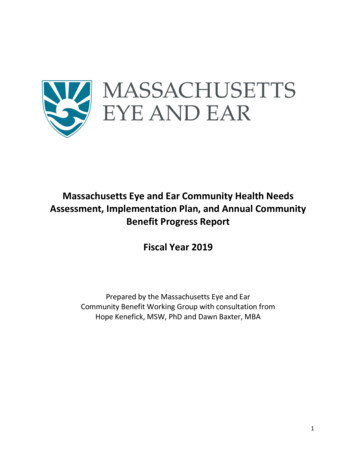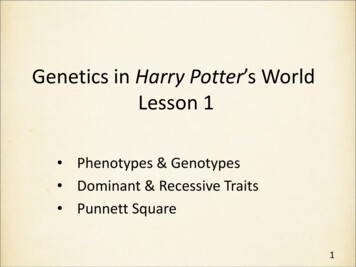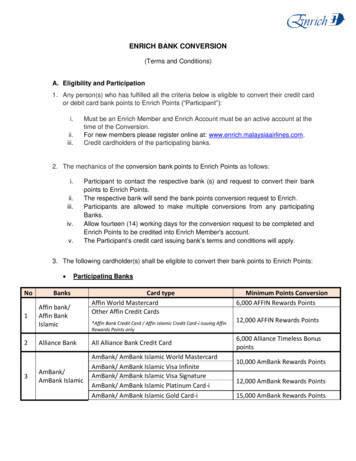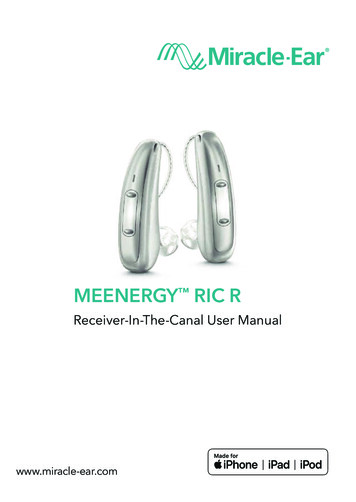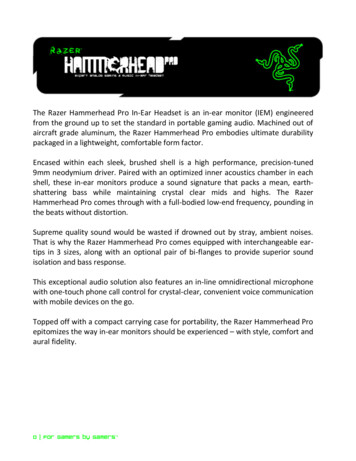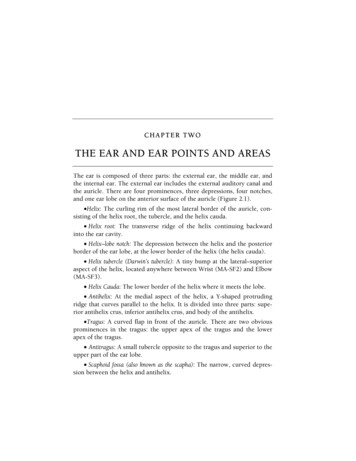
Transcription
15CHAPTER TWOTHE EAR AND EAR POINTS AND AREASThe ear is composed of three parts: the external ear, the middle ear, andthe internal ear. The external ear includes the external auditory canal andthe auricle. There are four prominences, three depressions, four notches,and one ear lobe on the anterior surface of the auricle (Figure 2.1). Helix: The curling rim of the most lateral border of the auricle, consisting of the helix root, the tubercle, and the helix cauda. Helix root: The transverse ridge of the helix continuing backwardinto the ear cavity. Helix–lobe notch: The depression between the helix and the posteriorborder of the ear lobe, at the lower border of the helix (the helix cauda). Helix tubercle (Darwin’s tubercle): A tiny bump at the lateral–superioraspect of the helix, located anywhere between Wrist (MA-SF2) and Elbow(MA-SF3). Helix Cauda: The lower border of the helix where it meets the lobe. Antihelix: At the medial aspect of the helix, a Y-shaped protrudingridge that curves parallel to the helix. It is divided into three parts: superior antihelix crus, inferior antihelix crus, and body of the antihelix. Tragus: A curved flap in front of the auricle. There are two obviousprominences in the tragus: the upper apex of the tragus and the lowerapex of the tragus. Antitragus: A small tubercle opposite to the tragus and superior to theupper part of the ear lobe. Scaphoid fossa (also known as the scapha): The narrow, curved depression between the helix and antihelix.
16Chapter Two The Ear and Ear Points and AreasAnatomical Areas on the Anterior Surface of the AuricleFigure 2.1: Anatomical Areas on the Anterior Surface of the Ear Triangular fossa: The triangular depression between the two crusa ofthe antihelix. Concha: The depression encircled by the antitragus, the curving partof the antihelix, and the inferior antihelix crus. It consists of two parts:superior concha and inferior concha. The raised area of the concha posterior to the helix root is the concha ridge. Lobe: The lowest part of the auricle; it has no cartilage. Supratragic notch: The depression between the upper border of thetragus and the helix root. Intertragic notch: The depression between the tragus and the antitragus. Antihelix–antitragus notch: The depression between the antihelix andthe antitragus.
Chapter Two The Ear and Ear Points and Areas17Anatomical Areas on the Posterior Surface of the AuricleThere are three flat areas, five grooves, and four prominences on theposterior surface of the auricle (Figure 2.2).Figure 2.2: Anatomical Areas on the Posterior Surface of the Ear Posterior surface of the helix: Lateral aspect of the helix from the helixcurving forward, from the frontal aspect. Posterior surface of the helix cauda: The flat area between the posteriorsurfaces of the scaphoid fossa and ear lobe. Posterior surface of the lobe: The flat area that is the posterior surfaceof the lobe. Posterior groove of antihelix body: The groove in the posterior surface ofthe antihelix body (where the ear attaches). Posterior groove of the superior antihelix crus: The depression on theposterior surface of the superior antihelix crus.
42Chapter Two The Ear and Ear Points and AreasFigure 2.13: Points and Areas on the Superior Concha of the EarSMALL INTESTINE (MA-SC2)Location: On the superior concha at superior and middle aspectof the helix root.Functions: Disperse accumulations and transform food.Indications: Maldigestion, abdominal distention, diarrhea, sorethroat, sores in mouth. This is also a supplementary point fortreating arrhythmia.
Chapter Two The Ear and Ear Points and Areas43APPENDIX (MA-SC3)Location: A point on the superior concha, between Large Intestine (MA-SC4) and Small Intestine (MA-SC2).Functions: Dispel stasis and free the network vessels; resolvetetany and relieve pain.Indications: Appendicitis, loose stools.LARGE INTESTINE (MA-SC4)Location: Superior concha, anterior and superior to the helix root.Functions: Dispel wind, clear heat, and free the bowels.Indications: Loose stools, constipation, cough, toothache, acne.LIVER (MA-SC5)Location: Posterior portion of the lower aspect of the superiorconcha, anterior to Chest (MA-AH11) and superior to Spleen(MA-IC).Functions: Course the liver and rectify qû; brighten the eyes andextinguish wind.Indications: Acute or chronic hepatitis, cholecystitis, cholelithiasis, distention and pain in the upper abdomen, belching, acidregurgitation; dizziness, convulsion, hemiparesis; myopia, sty,and acute conjunctivitis.PANCREAS/GALLBLADDER (MA-SC6)Location: Superior concha, between Liver (MA-SC5) and Kidney (MA-SC).Functions: Course and disinhibit the liver and gallbladder; freethe network vessels and relieve pain.Indications: Cholecystitis, cholelithiasis, parasitic diseases of thebiliary tract; acute or chronic pancreatitis; migraine, deafness,and tinnitus.KIDNEY (MA-SC)Location: Superior concha, inferior to Buttocks (MA-AH5) andposterior to and level with Bladder (MA-SC8).Functions: Supplement kidney and boost essence; strengthenlumbus and invigorate bones.Indications: Disorders of urinary and reproductive systems suchas nephritis, cystitis, impotence, seminal emission; dysmenorrhea, amenorrhea; deafness, tinnitus, retardation of hearing,loss of hair; disorders of the nervous system such as poor development of the brain, headache, spinal retrograde degeneration, pain in lumbus, rheumatoid arthritis, chronic diarrhea,frequent urination at night, bedwetting.
Chapter Five: Treatments for Common Disorders91CHAPTER FIVETREATMENTSFORCOMMON DISORDERSThe case studies with comments in this section are from the clinical records of Dr. Yang Yun Bi, at the Medical School of Huang Shan (YellowMountain City) in Anhui Province, PRC.INFECTIOUS DISORDERSCommon ColdTREATMENT PRESCRIPTIONPrimary Points: Lung (MA-IC1), Internal Nose (MA-T), Kidney (MA-SC),Ear Shén Mén (MA-TF1).Supplementary Points: Ear Apex (MA-H6) and Helix 1-6 (MA-H1-6) for fever; Forehead (MA-AT), Kidney (MA-SC), and Spleen (MA-IC)for headache and aching; Pharynx and Larynx (MA-T3) for sore throat;Bronchii/Trachea (MA-IC2) and Calm Panting (MA-AT) for cough; Stomach (MA-IC) and Spleen (MA-IC) for diarrhea and vomiting.THERAPEUTIC METHODSEar Acupuncture: Select two or three primary points together withone or two supplementary points. The needles should be forcefully rotatedto create intense stimulation. Two treatments per day are recommendedfor a severe case. Retain the needles for 30 to 60 minutes and manipulateevery 10 to 15 minutes. Decrease treatments to once per day as the illnessimproves.Ear Acupressure: Affix seeds to selected points in both ears. Pressthe seeds three to five times per day (morning, noon, afternoon, and evening), three to five minutes each time.
92Chapter Five: Treatments for Common DisordersBloodletting: To be used in those with fever. Ear Apex (MA-H6) andHelix 1-6 (MA-H 1-6) are treated.NOTES Clinical practice shows that ear acupuncture not only treats the common cold, but can also prevent it. As a preventative measure for cases ofrepeated attack of the common cold due to a weak constitution or in aperiod of epidemic of influenza, apply ear acupuncture, ear acupressure,or massage at Lung (MA-IC1), Spleen (MA-IC), and Kidney (MA-SC).According to TCM, Lung (MA-IC1) diffuses the lung and resolves theexterior; it thereby frees the nose and thus is the primary point for thetreatment of common cold and influenza. Kidney (MA-SC) is antiinflammatory and anti-allergic, so it is effective for runny nose and excessive lacrimation when combined with Lung (MA-IC1). Bleeding atEar Apex (MA-H6) and Helix 1-6 (MA-H 1-6) clears lung heat. Severecases of influenza or pneumonic common cold should be treated withear acupuncture in combination with other therapies.CASE STUDY: COMMON COLDZhang, a 20-year-old female, reported that for two days she had headache, fever, nasal congestion with runny nose, and sore throat. Herbody temperature was 38º C; there was redness and swelling inher throat. The diagnosis was “common cold.”Treatment Prescription: Ear Apex (MA-H6), Internal Nose (MA-T),Throat (MA-T3), Lung (MA-IC1), Adrenal Gland (MA-T), andOcciput (MA-AT).Therapeutic Method: Bleeding at Ear Apex (MA-H6) with three-edgedneedle; seed acupressure for the other points. Both ears weretreated simultaneously, twice a week. The patient was told to pressthe seeds three to five times per day during the treatment.Treatment Results: The patient’s body temperature returned to normal; all other symptoms showed improvement six hours after thefirst treatment. All the symptoms were gone after three treatments.COMMENTS:1. Bleeding at Ear Apex (MA-H6), usually by drawing three drops ofblood, is remarkably effective for reducing body temperature.2. In common cold, the identified patterns can change very quickly. Othertherapies should be considered whenever a complication occurs.
Chapter Five: Treatments for Common Disorders93Epidemic Parotitis/MumpsTREATMENT PRESCRIPTION 1Primary Points: Apex of Antitragus (MA-AT), Cheek (MA-L), AdrenalGland (MA-T) and Ear Apex (MA-H6).Supplementary Points: Endocrine (MA-IC3), Subcortex (MA-AT1),Stomach (MA-IC), Pancreas/Gallbladder (MA-SC6), and Ear Shén Mén(MA-TF1).THERAPEUTIC METHODEar Acupuncture: Use all the primary points together with one ortwo supplementary points, according to the patient’s condition. The needles should be retained for 30 minutes and forcefully rotated every 10minutes to achieve strong stimulation. Treat one or two times per day onboth ears.TREATMENT PRESCRIPTION 2Primary Points: Parotid Gland (MA-AT), Ear Apex (MA-H6), andEar Shén Mén (MA-TF1).THERAPEUTIC METHODEar Acupressure: Affix seeds to all prescribed points on both ears.Press the seeds three to five times per day, two to three minutes each time,until the swelling is decreased. This should occur in two to four days.TREATMENT PRESCRIPTION 3Primary Points: Ear Apex (MA-H6).THERAPEUTIC METHODBloodletting: Puncture Ear Apex (MA-H6) on both ears with a threeedged needle to draw ten drops of blood. Treat once per day for commoncases, two treatments for severe cases.CASE STUDY: EPIDEMIC MUMPSChen, a 5-year-old girl, had suffered from fever and painful swollencheeks for three days. Her body temperature was 38º C; she hadswelling and tenderness centered at the ear lobes and extending toboth cheeks and surrounding area. The diagnosis was “epidemicmumps.”Treatment Prescription: Apex of Antitragus (MA-AT), Cheek (MA-L),Ear Apex (MA-H6), Adrenal Gland (MA-T), and Subcortex (MAAT1).Therapeutic Method: Bleeding at Ear Apex (MA-H6) with a threeedged needle. The other points were needled with filiform needleson both ears. The needles were retained for 30 minutes.
94Chapter Five: Treatments for Common DisordersTreatment Results: Pain was greatly improved after the first treatment,and all the symptoms were gone after two treatments. The patienttook no other medication or therapy during the treatment with earacupuncture.Comment: Considering that children are afraid of needling, seed acupressure can also be effective for the treatment of this disorder.Whooping CoughTREATMENT PRESCRIPTIONPrimary Points: Bronchi (MA-IC), Lung (MA-IC1), Ear Shén Mén(MA-TF1), and Sympathetic (MA-AH7).Supplementary Points: Large Intestine (MA-SC4), Ear Apex (MA-H6),Apex of Antitragus (MA-AT), Subcortex (MA-AT1), Adrenal Gland (MA-T),and Kidney (MA-SC).THERAPEUTIC METHODSEar Acupuncture: Use all the primary points together with one ortwo supplementary points according to the patient’s current condition; forexample, select Ear Apex (MA-H6) and Apex of Antitragus (MA-AT) atthe early stage; select Subcortex (MA-AT1) and Adrenal Gland (MA-T) atthe spasmodic cough stage; and select Kidney (MA-SC) and Ear ShénMén (MA-TF1) at the recovery stage. Rotate the inserted needles, thenremove them immediately. One treatment per day is done at both the earlystage and the recovery stage; treat two or three times per day at the paroxysmal cough stage. Begin treatment on a single ear and change to the opposite ear every other day. One treatment course is seven days; allow twoto three days between treatment courses.Bloodletting: After routine sterilization, draw two to three drops ofblood using a sterilized three-edged needle at Ear Apex (MA-H6) everyother day. This treatment is for those with fever at the early stage.CASE STUDY: WHOOPING COUGHWang, a 7-year-old boy, suffered from cough for one month. The paroxysmal coughing was aggravated at night and was followed bychicken-crowing-like breathing with scanty white foamy sputum.Sometimes when the cough was severe it resulted in vomiting. Theboy also had congestion of the bulbar conjunctiva in both eyes anda slightly puffy face. Auscultation revealed rough breathing onboth sides of the lung. An X-ray exam showed no other diseases inthe lungs. The diagnosis was “whooping cough.”Treatment Prescription: Bronchii/Trachea (MA-IC2), Lung (MA-IC1),Adrenal Gland (MA-T), Mouth (MA-IC5), and Central Rim (MA-AT).
Chapter Five: Treatments for Common Disorders95Therapeutic Method: The initial treatment selection was needling atthe above points on both ears.Treatment Results: The patient’s cough was remarkably improved thevery night of the first treatment. Seed acupressure was used fromthe second treatment on the following day; both ears were treatedonce per day. All the symptoms were gone after seven treatments,and one more treatment was added to strengthen the therapeuticeffect.Comment: Ear acupuncture is better for whooping cough at late stagemarked by dry cough because it can reduce the sensitivity of newepifollicles in the trachea and bronchus, as well as inhibit the respiratory center in the brain stem.TuberculosisTREATMENT PRESCRIPTION 1Primary Points: Lung (MA-IC1), Endocrine (MA-IC3), and Ear ShénMén (MA-TF1).Supplementary Points: Chest (MA-AH11), Kidney (MA-SC), Spleen(MA-IC), Stomach (MA-IC), Internal Reproductive Organs (MA-TF), andPelvis (MA-TF).THERAPEUTIC METHODSEar Acupuncture: Use all the primary points together with one ortwo supplementary points depending on the patient’s condition. For example, add Chest (MA-AH11) and Kidney (MA-SC) for cough and chestpain; add Spleen (MA-IC) and Stomach (MA-IC) for poor appetite; addInternal Reproductive Organs (MA-TF) and Pelvis (MA-TF) for irregularmenstrual cycle and amenorrhea. Manipulate by needle scratching or rotation the inserted needles, using mild stimulation. Treat once per day. Begin treatment on a single ear and change to the opposite ear every otherday. One treatment course is ten days; allow two or three days betweentreatment courses.Ear Acupressure: Affix whole round mung beans at all prescribedpoints. Press three to five times each day, two to three minutes each time.Begin treatment on a single ear and change to the opposite ear every fiveto seven days.TREATMENT PRESCRIPTION 2Primary Points: Lung (MA-IC1), Endocrine (MA-IC3), Ear Shén Mén(MA-TF1), Heart (MA-IC), Spleen (MA-IC), Subcortex (MA-AT1), andKidney (MA-SC).
96Chapter Five: Treatments for Common DisordersTHERAPEUTIC METHODMedicine Injection: Inject 0.1 ml of 0.75% Novocain or 5–10 mgisoniazid into one or two points to make soybean-sized bumps. Begintreatment on a single ear and change to the opposite ear every other day.Treat once per day; a single treatment course is three months.NOTES Verify that the needle is not inserted into a blood vessel by drawingback the syringe to check for blood before injecting the medicine intothe points.This disease requires long-term treatment.HepatitisTREATMENT PRESCRIPTION 1Primary Points: Liver (MA-SC5), Pancreas/Gallbladder (MA-SC6),Spleen (MA-IC), and Stomach (MA-IC).Supplementary Points: Add Pancreas/Gallbladder (MA-SC6) andAbdomen (MA-AH) for poor appetite; add Ear Shén Mén (MA-TF1) andSubcortex (MA-AT1) for pain in the right upper abdomen; add Large Intestine (MA-SC4) and Pancreas/Gallbladder (MA-SC6) for distention ofthe abdomen; add Heart (MA-IC), Ear Shén Mén (MA-TF1), and Subcortex (MA-AT1) for insomnia; add Liver Yáng (MA-H) and Ear Apex(MA-H6) to reduce the amount of SGPT and SGOP9.THERAPEUTIC METHODSEar Acupuncture: Select four to six points and apply needle rotationand scratching. Retain the needles for 60 minutes and manipulate themevery ten to fifteen minutes. Treat once per day. Begin treatment on a single ear and change to the opposite ear every other day. One treatmentcourse is seven to ten days; allow two or three days between treatmentcourses.Medicine Injection: Use two or three points for each treatment. Inject 0.1 ml of 0.5% Novocain and 0.2–0.5 ml of vitamin B12 into the prescribed points. Begin treatment on a single ear and change to the oppositeear every other day. One treatment course is ten days.TREATMENT PRESCRIPTION 2Primary Points: Liver (MA-SC5), Pancreas/Gallbladder (MA-SC6),Spleen (MA-IC), Stomach (MA-IC), SÃn JiÃo (MA-IC4), and Ear Center(MA-H1).9These are measures of particular liver functions.
Chapter Five: Treatments for Common Disorders97Supplementary Points: Use Ear Apex (MA-H6) for bloodletting; addLiver Yáng (MA-H) and Abdomen (MA-AH) for distention of the abdomen;add Bladder (MA-SC8), Ear Shén Mén (MA-TF1), and Chest (MA-AH11)for pain near the liver.THERAPEUTIC METHODSElectroacupuncture: Select two or three primary points togetherwith one or two supplementary points. After sterilizing the auricle, insertfiliform needles into the selected points. Then connect the needles to anelectroacupuncture apparatus for 30 minutes at a setting that causes thepatient to feel soreness, numbness, and distention. Treat once per day.Begin treatment on a single ear and change to the opposite ear every otherday. One treatment course is ten days.Ear Acupressure: Select two or three primary points together withone or two supplementary points. Affix vaccaria seeds at the selectedpoints. Press the seeds after each meal and before going to sleep; rub fortwo to three minutes each time or until soreness, numbness, or distentionis induced.Bacillary Dysentery/DysenteryTREATMENT PRESCRIPTIONPrimary Points: Large Intestine (MA-SC4), Rectum (MA-H2), andSympathetic (MA-AH7).Supplementary Points: Add Ear Apex (MA-H6) and Adrenal Gland(MA-T) for high fever; add Spleen (MA-IC) and Stomach (MA-IC) for severe abdominal pain and diarrhea.THERAPEUTIC METHODSEar Acupuncture: Select two or three primary points together withone or two supplementary points. Treat both ears, using strong stimulation by forcefully rotating. Retain the needles for 60 minutes and manipulate every 10 or 15 minutes. Treat once per day for mild cases, twice perday for severe cases.Medicine Injection: Inject 0.1 ml of syntomycin, vitamin B1, or Novocain at two or three of the prescribed points, once per day. Begin treatment on a single ear and change to the opposite ear every other day untildiarrhea stops. One more injection should be given after bacterial cultureresults are normal. Atropine sulfate can also be used for the medicine injection method. Treat Ear Shén Mén (MA-TF1), Sympathetic (MA-AH7),and Large Intestine (MA-SC4) bilaterally; add Rectum (MA-H2) for tenesmus. Inject 0.15 ml for each point, and treat once or twice per day.
98Chapter Five: Treatments for Common DisordersNeedle Implantation: Select three to five of the points in one ear forneedle implantation. Press the implanted needles two or three times perday, two to three minutes each time. The intradermal needles should remain implanted for five to seven days. In general, all signs of illness willdisappear after only one treatment course.NOTES Patients with toxic types of bacillary dysentery with severe manifestations should be treated on an inpatient basis using a combination oftherapies.MalariaTREATMENT PRESCRIPTIONPrimary Points: Adrenal Gland (MA-T), Subcortex (MA-AT1), andEndocrine (MA-IC3).THERAPEUTIC METHODSEar Acupuncture: Select all prescribed points in both ears, usingstrong stimulation by rotating forcefully. Needling should be done sevenhours before an attack, and the needles should be retained until one totwo hours after the attack ends; manipulate the needles every 15 to 20minutes.Needle Implantation: Implant needles at the prescribed points inboth ears two hours before an attack occurs. Press the implanted needlesthree to five times each day, three to five minutes each time. The needlesshould remain implanted until two or three days after the attacks stop.NOTES Cerebral malaria and severe cases of malaria must be treated with acombination of therapies at an inpatient clinic.INTERNAL DISORDERSBronchitisTREATMENT PRESCRIPTION 1Primary Points: Lung (MA-IC1), Bronchii/Trachea (MA-IC2), andEar Shén Mén (MA-TF1).Supplementary Points: Add Adrenal Gland (MA-T) and Root of EarVagus (MA-PS) for acute bronchitis; add Spleen (MA-IC) and Kidney (MA-SC) for chronic bronchitis; add Calm Panting (MA-AT) for pulmonary emphysema.
Chapter Five: Treatments for Common Disorders99THERAPEUTIC METHODSEar Acupuncture: Select two or three primary points together withone or two supplementary points. Retain the needles for 30 to 60 minutesand manipulate every 10 to 15 minutes, use needle rotation for strongstimulation. Treat once per day. Begin treatment on a single ear andchange to the opposite ear every other day. One treatment course is five toseven days; allow two or three days between treatment courses.Ear Acupressure: Affix seeds at three to five prescribed points. Pressthe seeds three to five times per day, two to three minutes each time. Begin treatment on a single ear and change to the opposite ear after five toseven days. This method is mainly used to treat chronic bronchitis.TREATMENT PRESCRIPTION 2Primary Points: Lung (MA-IC1), Kidney (MA-SC), Calm Panting(MA-AT), and Bronchii/Trachea (MA-IC2).THERAPEUTIC METHODMedicine Injection: Select one or two of the prescribed points, andinject a prepared bacteria concoction.10 Use 0.05–0.1 ml for the first injection, gradually increasing the amount to 0.3 ml. Treat two times per week.One treatment course is ten treatments.CASE STUDY: BRONCHITISYao, a 20-year-old male, reported that for five days he had cough withfrothy sputum, which was aggravated at night. After treatmentwith Western medication, the amount of sputum was remarkablyreduced but the cough had not significantly improved. The patient’s body temperature was normal. Auscultation revealed roughbreath on both sides of the lung, and an X-ray exam showed noother diseases in the lungs. The diagnosis was “acute bronchitis.”Treatment Prescription: Bronchii/Trachea (MA-IC2), Lung (MA-IC1),Ear Shén Mén (MA-TF1), Mouth (MA-IC5), Central Rim (MAAT), and Endocrine (MA-IC3).Therapeutic Method: In the first treatment, both ears were needledand the needles were retained for 30 minutes. Seed acupressurewas used starting with the second treatment.Treatment Results: The cough was remarkably improved at night afterthe first treatment, and the patient was cured after three treatments.Comments: 1. Ear acupuncture is more effective for bronchitis in anearly stage or when dry cough with inflammation is under control.10This concoction is a type of complex bacterial vaccine that combines hay bacillus withstreptococcus and staphylococcus albus.
100Chapter Five: Treatments for Common Disorders2. Chronic bronchitis is frequently complicated with inflammation, and ear acupuncture can only provide symptomatic reliefand shorten the course of illness. For better therapeutic results,other complementary therapies should be used.Bronchial Asthma/Wheezing and PantingTREATMENT PRESCRIPTIONPrimary Points: Lung (MA-IC1), Kidney (MA-SC), Ear Shén Mén(MA-TF1), Adrenal Gland (MA-T), and Sympathetic (MA-AH7).Supplementary Points: Add Bronchii/Trachea (MA-IC2) for severecough; add Chest (MA-AH11) and Subcortex (MA-AT1) for severe panting.THERAPEUTIC METHODSMedicine Injection: Use 0.2% Novocain or 1:1000 adrenaline. Selecttwo or three prescribed points and inject 0.1 ml of the preparation intoeach point. This method is recommended for acute cases.Ear Acupuncture: Use all primary points, together with one or twosupplementary points. Retain the needles for 30 to 60 minutes and manipulate every 10 to 15 minutes, using needle scratching and rotation manipulation. Treat once per day. Begin treatment on a single ear and changeto the opposite each every other day. One treatment course is seven days.Ear Acupressure: Use white mustard seed. Rub seeds three to fivetimes per day, two to three minutes each time. Begin treatment on a singleear and change to the opposite ear every five to seven days.NOTE Ear acupressure is used as a preventative treatment during intervalsbetween acute attacks of asthma.CASE STUDY: BRONCHIAL ASTHMAFor the last 8 years Wang, a 19-year-old male, had suffered fromasthma that was triggered by seasonal changes, catching cold, andoverwork. Two days prior to his first treatment, he had suddenonset of asthma marked by difficult breathing, white frothy sputum, slightly purple lips, and wheezing sounds on both sides ofthe chest. The diagnosis was “bronchial asthma.”Treatment Prescription: Bronchii/Trachea (MA-IC2), Lung (MA-IC1),Kidney (MA-SC), Sympathetic (MA-AH7), Adrenal Gland (MA-T),Subcortex (MA-AT1), and Endocrine (MA-IC3).Therapeutic Method: All the above points were needled on both ears;later, seed acupressure was used.
Chapter Five: Treatments for Common Disorders101Treatment Results: The asthma was significantly relieved within twohours of the first treatment. At the second treatment on the following day and thereafter, seed acupressure was used; treatmentsswitched between ears every three to five days. All the symptomswere gone after four treatments.Comments: 1. Ear acupuncture can only relieve the symptoms at theacute onset of asthma by relaxing spasms of the bronchial smoothmuscle. It does not help for complete healing.2. As for bronchial asthma complicated with infection, ananti-inflammatory medicinal treatment should be added.HypertensionTREATMENT PRESCRIPTION 1Primary Points: Groove of Posterior Surface (MA-PS), Liver (MA-SC5),and Spleen (MA-IC).THERAPEUTIC METHODBloodletting: Draw five to ten drops of blood from each of the prescribed points. Begin treatment on a single ear and change to the oppositeear every other session. For the best effect, treatment should continueevery two or three days, even after blood pressure returns to normal.NOTES Blood pressure may rise at the beginning of treatment in some patients, but it will gradually decline.TREATMENT PRESCRIPTION 2Primary Points: Adrenal Gland (MA-T), Sympathetic (MA-AH7),Heart (MA-IC), and Ear Shén Mén (MA-TF1).Supplementary Points: Liver (MA-SC5), Kidney (MA-SC), Endocrine (MA-IC3), and Subcortex (MA-AT1).THERAPEUTIC METHODSMagnet Therapy: Use all the primary points together with one or twosupplementary points. Select magnetic beads with a diameter of 1.5 to 2.0mm and a magnetic intensity of 0.05 to 0.08 teslae (500 to 800G). Affixthe beads onto the selected points. Begin treatment on a single ear andchange to the opposite ear every five to seven days.Ear Acupressure: Affix vaccaria seeds on two or three primary pointstogether with one or two supplementary points. Press three to five timesper day, two to three minutes each time. Begin treatment on a single earand change to the opposite ear every five to seven days.
dles should be retained for 30 minutes and forcefully rotated every 10 minutes to achieve strong stimulation. Treat one or two times per day on both ears. TREATMENT PRESCRIPTION 2 Primary Points: Parotid Gland (MA-AT), Ear Apex (MA-H6), and Ear Shén Mén (MA-TF1). THERAPEUTIC METHOD Ear Acupressure: Affix seeds to all prescribed points on both .


